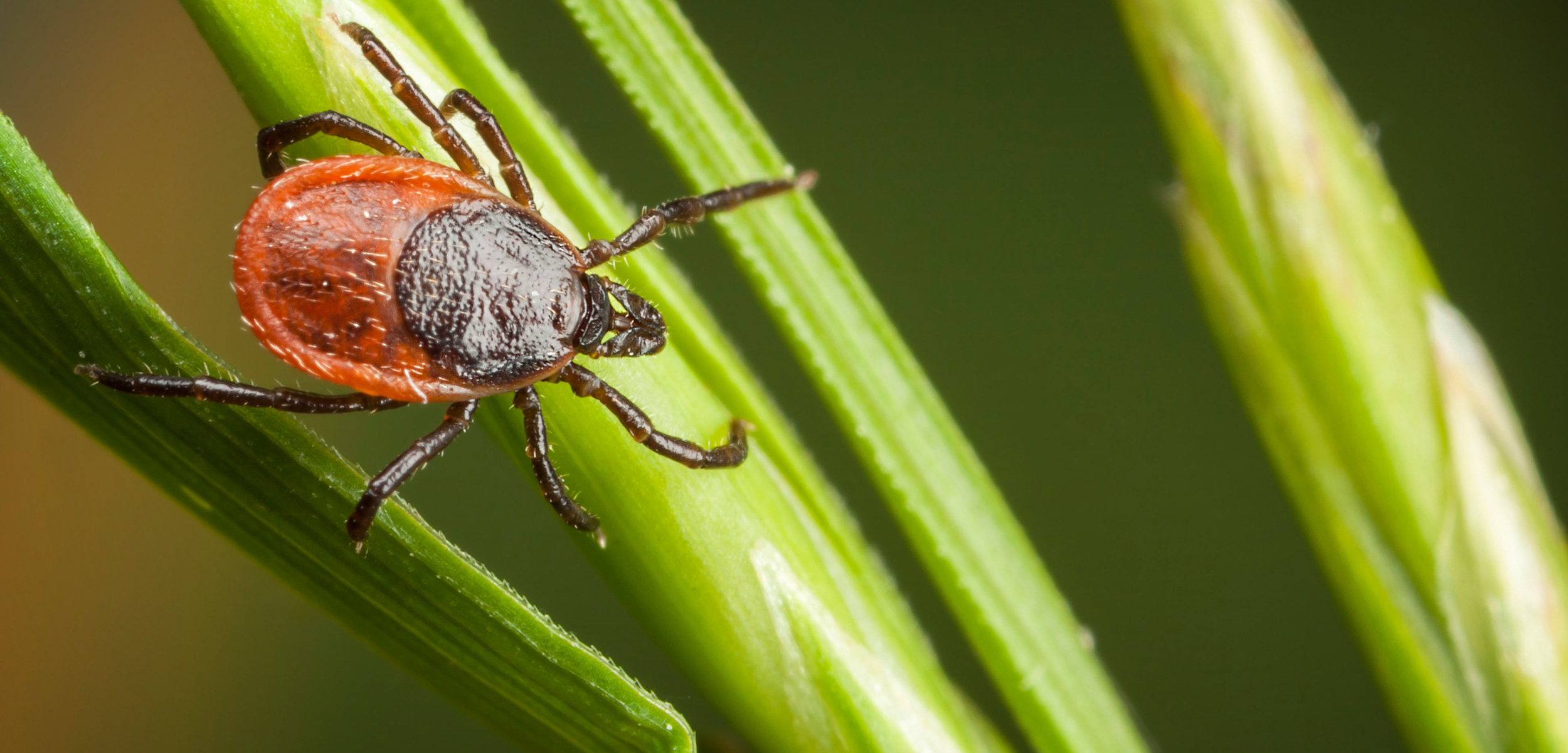Ticked Off on Martha’s Vineyard
Forget rubbing elbows with the rich and famous, you’re more likely to get Lyme disease on the island.
Article body copy
“You see a louse on someone else, but not a tick on yourself.” Gaius Petronius Arbiter, 27-66 CE, Roman satirical writer
Everything begins with my wife cheerily announcing: “I’ve booked a place for 10 days on the Vineyard.” The “the” tells those in the know that the site is Martha’s Vineyard, an island off the coast of Cape Cod, Massachusetts. It’s the place where Barack Obama and his family regularly vacation, where the eponymous summer blockbuster Jaws was filmed, and where there seem to be more Harvard and Yale professors per square meter than on their respective campuses. When I hear its name, I experience what is known as a klong.
The Urban Dictionary describes klong succinctly: a sudden rush of shit to the heart. The klong comes to me because, in addition to its attraction for the rich and famous and intellectual, Martha’s Vineyard and its sister island, Nantucket, are often in the running for the title of tick-borne Lyme disease capital of the United States. For those inattentive to the myriad health-destroying illnesses out there, Lyme disease is an inflammatory bacterial disease, which, if undiagnosed, has the potential to leave a person chronically sick. And on Martha’s Vineyard, when you talk to some of the roughly 16,000 year-round residents, almost invariably they tell you that they—or someone they know—have had Lyme disease or a related tick-borne illness. They will also almost invariably tell you how they—or someone they know—are now perennially sick.
So what my wife sees as a sublime ocean spot where you can go barefoot to the beach and eat fresh seafood daily and be stopped by Carly Simon—legendary singer-songwriter and Academy Award winner—and asked where you bought that great sweater, I see as a plague zone. I see it as Stephen Strauss klong central.
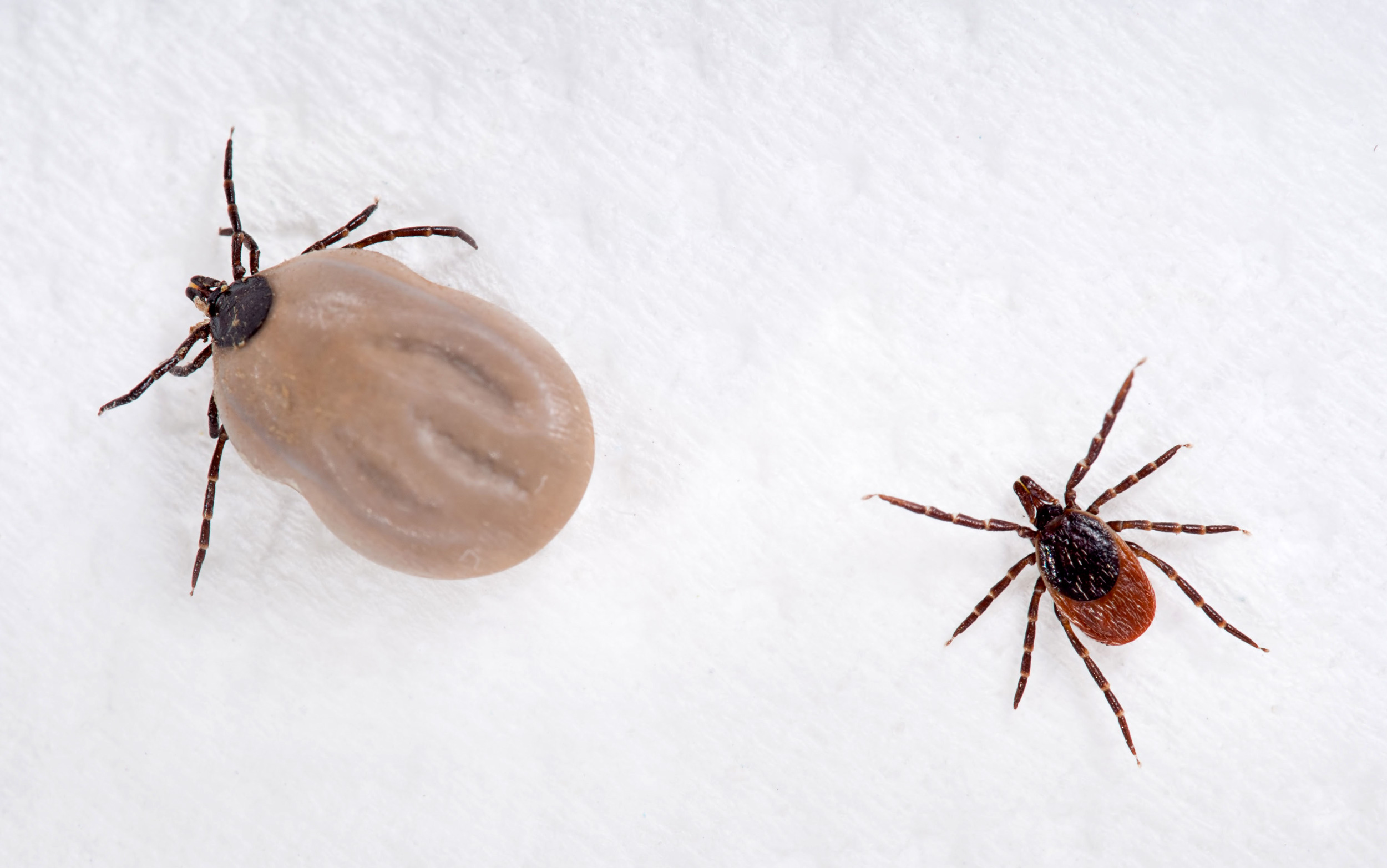
An engorged deer tick and an unengorged deer tick. Lyme infections are usually passed through the bites of nymphs, pre-adult stage ticks. Nymphs are particularly hard to spot since they’re only about two millimeters long. Photo by StellaPhotography/Alamy Stock Photo
All of which has led me to agree to go to the Vineyard, but I plan for a very different vacation, not a typical beach sojourn on what the New York Times has called an island utopia. Instead I want to immerse myself in a tick-inspired exploration vacation: how have ticks changed Martha’s Vineyard’s sense of self, its civic culture, and its view of nature?
I also want to know: am I just paranoid? And, somewhat subversively, might doing this investigation make for a more interesting—maybe even great—trip for me?
Tick Hunting with Dick
If you don’t find ticks alarming, July on Martha’s Vineyard is heavenly, with perfect beach weather. Since I am alarmed, it’s fitting that my vacation begins with a tick-trapping safari to remote Cape Poge on neighboring Chappaquiddick Island, known as “Chappy,” technically a peninsula of Martha’s Vineyard, but, periodically an island when a passing storm breaks its sandy connection.

A ferry transports residents and visitors between Martha’s Vineyard and Chappaquiddick Island, a popular destination for hikers, fishers, and other vacationers. Photo by Mila Lowe
Tall, white-bearded, and professionally scruffy in permethrin-doused clothing, Dick Johnson chats about all things tick as we wait for the five-minute ferry ride. He repeatedly pauses to greet people and talk ticks, almost as if the 21st-century equivalent of the friendly island postman is Dick Johnson, the friendly island tickman.
I’ve done a fair amount of background research, but I am unprepared for what Johnson tells me about his most recent tick safaris. The Vineyard’s tick populations seem to be changing. Traditionally, islanders have primarily dealt with dog ticks (which don’t carry Lyme disease) and deer ticks (which do carry Lyme disease). But a species relatively new to the neighborhood has materialized in larger numbers in local yards—lone star ticks. While observed since the 1980s, the lone star population has remained small. Until now. In 2014, Johnson surveyed 82 houses on Chappy and counted 42 lone star ticks; less than a year later, that number jumped to 250 in total with 100 on one property alone.
The lone star tick gets its name from the white spot on the adult female’s back and is most prevalent in the south. For islanders, the fear of the new tick relates to how different lone stars are from the more familiar species. “The problem with lone stars is that they can see and they are very aggressive,” Johnson says. I listen intently, along with the Chappy ferry toll guard. Deer and dog ticks are opportunists. “Unless you brush against the branch or leaves on which the ticks sit, they generally will leave you alone,” Johnson explains. But “the lone star will come across sand and come after you. They are like sprinters and they run really fast. And unlike ticks whose bites often go unnoticed, lone star tick bites really hurt.” The toll guard and I grimace in unison.

Dick Johnson, a field biologist on Martha’s Vineyard, tracks tick populations on the island. There are a lot of ticks. A lot. Photo by Mila Lowe
But, worse than an almost vampireish will to cause harm, what has really freaked out Chappy residents, such as 72-year-old Donald Greenstein whose yard our tick safari will be conducted in, is one of the diseases carried by lone star ticks—tularemia. Untreated Lyme disease can lead to a life sentence of pain, but you live. Tularemia, though less common, tends to worry people more: the Type A strain causes fatalities in roughly two percent of reported cases in the United States. The disease is so potentially lethal that it has been flagged as a possible future biological warfare weapon. Greenstein—who, like Johnson, wears tick-proof clothing and looks absolutely unlike a person spending a summer day at the beach—picks us up from the ferry. “I can take the pain from a bite, but once [tularemia] shows up … there is a 20 percent mortality rate within eight days,” Greenstein says, his fear reflected in his 10-fold exaggeration of the actual fatality figures.
Greenstein worries constantly about tularemia and lone stars, so much that he checks himself for ticks three or four times a day. He has also partnered with Johnson on an experimental tick control program, which involves mowing and cutting brush around his home. The approach is based on the concept that if ticks are exposed to a lot of sunlight, the heat and reduced humidity forces nymphs (pre-adult ticks) into hiding. This heat-induced disappearance is the principal reason Lyme disease season stalls on the Vineyard in August, after months of dry weather with temperatures reaching 30 ˚C or more. The ticks re-emerge in the fall, but it’s generally cooler, people wear more clothes, and less daylight means less time prancing about outdoors. There is no proof that lone star ticks respond to a hotter, drier environment by going into hiding, however, hence the experiment.
Greenstein’s simple, beachfront house looks out to the ocean and has a spectacular view of a historical lighthouse. We head to Greenstein’s test area—about the size of four tennis courts—for Johnson to hunt and count ticks. How do you hunt for ticks? Not with nets, and not with a scented insect trap, but with a tick dragger: an ordinary white towel attached to a pole. “Ticks will cling to anything,” Johnson explains. He lays the towel on areas where he knows ticks like to nestle, and after a short time he picks it up, turns it over, and, voila, we see dozens of little black dots. Some move; some just rest. Johnson, expert as he is in ticks, is animated as he points out which of his captives is a dog tick, a deer tick, lone star, or nymph. His expertise runs so deep he even distinguishes lone star males from females.
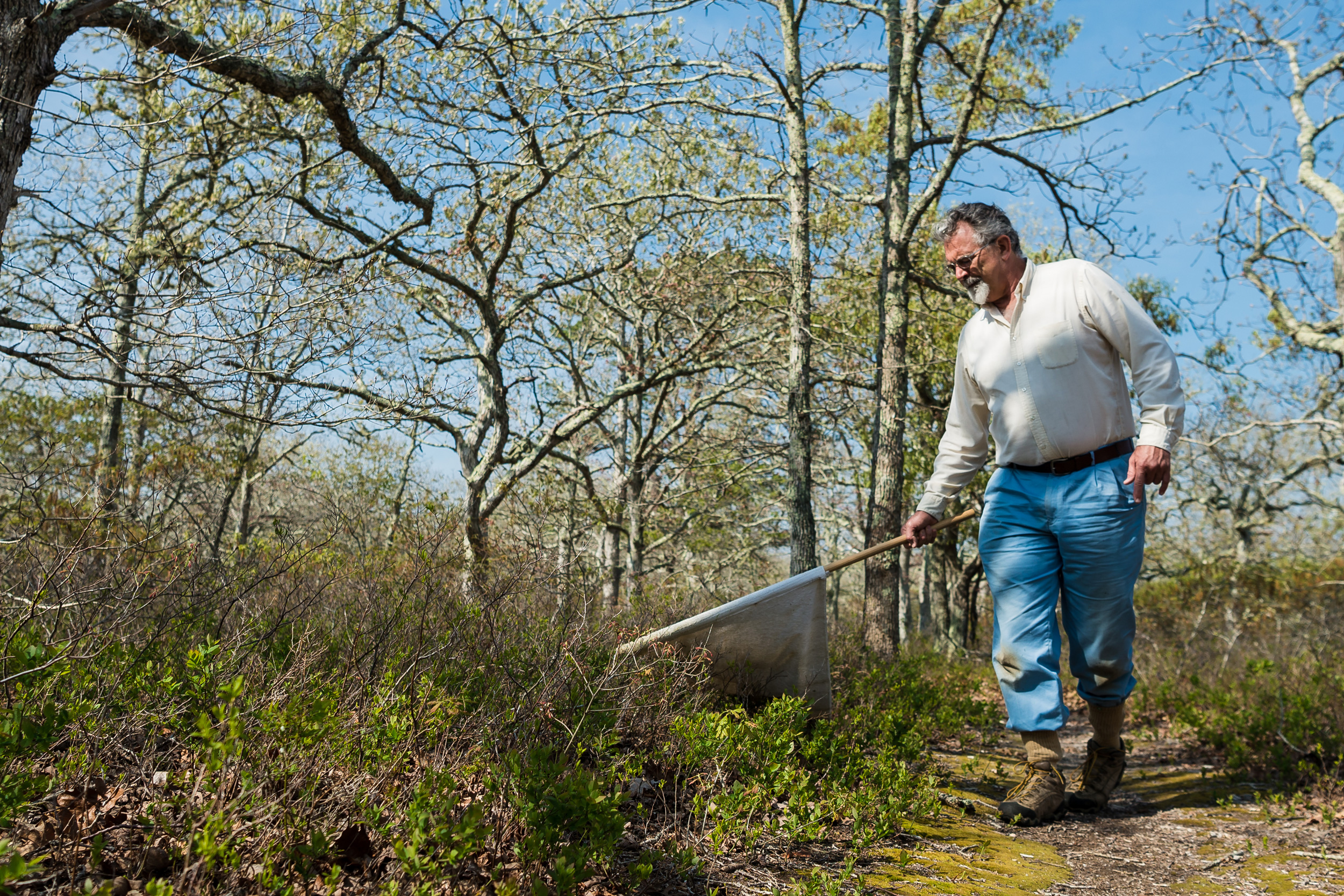
Dick Johnson uses his low-tech, yet highly effective, tick dragger to capture the animals, which cling to just about anything. Photo by Mila Lowe
He is tick-hunt excited but I am tick-hunt anxious. I am absolutely amazed at how many ticks he caught pretty much right under my feet and—I have to speak in italics—I didn’t see a single one. Not one. And, to me, that’s what is so scary about Martha’s Vineyard. I can see the mosquitoes when they are going to bite me; I can see the black flies or spiders or other small beings zeroing in on me. But I can’t see the ticks. They hunt me and I can’t see them.
Johnson takes a sticky roller and glides it over the towel to capture the ticks. He will send them to Sam Telford, a researcher at the veterinary school at Tufts University who has been studying ticks on Martha’s Vineyard, Nantucket, and elsewhere for more than 30 years. His lab will examine the ticks for a variety of things, including the diseases they carry.
When Johnson reveals that a significant number of ticks remain, Greenstein can’t quite believe that his cutting and mowing efforts haven’t worked. Johnson listens, nods, and explains with the preternatural calmness he uses to express most things tickish: the jury is still out on whether mowing works and there has been no consistent reduction of ticks in other test areas. But Greenstein wants to believe his efforts work—and he’s emphatic about it—because, well, lone star ticks and tularemia deeply frighten him.
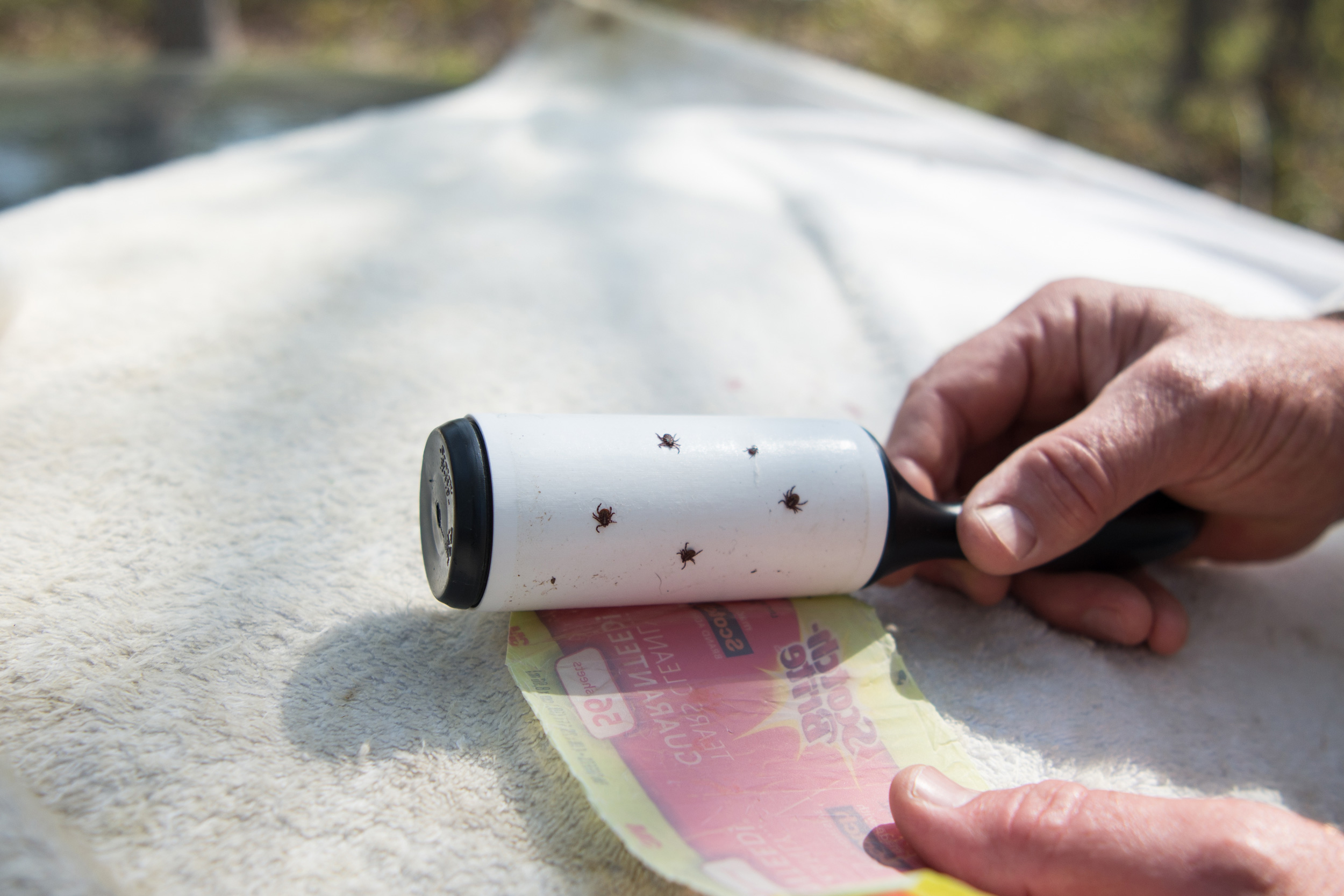
Searching for ticks is fairly low tech: a white towel on a long pole. The ticks cling to the towel and a sticky roller captures them for research. Photo by Mila Lowe
Though more fearful than others, Greenstein manifests what is an island-wide tick anxiety. Fears of tularemia may be raising the stakes, but Lyme disease angst has come to define the Vineyard.
When Ticks Came to Town
Lyme disease wormed its way into the North American consciousness in the 1970s, when a mysterious illness afflicted children in Lyme, Connecticut, and two nearby towns, about 130 kilometers away as the crow flies from Martha’s Vineyard. By the 1980s, scientists had identified the Borrelia burgdorferi bacterium, carried by deer ticks, as the cause of the disease. Soon, anyone who had a penchant for running through meadows and hiking through bush in affected areas feared the target-shaped rash and flu-like symptoms that could result from a bite.
Today that fear is a community obsession. The island’s weekly newspapers, the Vineyard Times and the Vineyard Gazette, regularly feature stories about Lyme disease. An archival search reveals 300 articles in the past several years; nine of them are “Telford talks ticks” columns written by Sam Telford, the Tufts researcher, in 2014. Search for “Martha’s Vineyard” and “Lyme disease” in Google Scholar and 196 references pop up. There is a Lyme Center of Martha’s Vineyard devoted to helping people who suffer from chronic Lyme disease. And, islanders are justified in their unease; the fact that it’s called Lyme is happenstance, given its prevalence it could easily have been named after the Vineyard or another town.
Martha’s Vineyard, along with other coastal areas of the US Northeast, may have a special place in tick history as a kind of promised land for North America’s ticks and the diseases they carry. In a phone conversation, tick-talking Telford tells me that he believes one of the reasons the Vineyard has so many ticks, and ticks infected with Lyme disease, is a result of the biological aftermath of the last ice age. Coastal areas on the edge of glaciers would have had relatively mild climates, serving as a refuge for many animals, including deer and the ticks that cling to them. Once the ice retreated, the coastline was also an ideal place for life to recolonize. While Telford admits there is no proof for this thesis, he believes it presents a good explanation as to why the Vineyard and similar coastal places are a present-day utopia for ticks and their diseases.
“There is indeed a relationship with the New England coastal sites and intensity of transmission,” Telford says. “When Lyme was new, generally the riskiest sites were within 30 miles [48 kilometers] of the coast. This is because temperature drives the tick life cycle and the coastal sites are nearly optimal.” Like humans, the Borrelia bacterium is high-temperature averse. If Lyme disease-infected ticks are held at 18 ˚C for eight months, 70 percent of ticks will still be infected. But if you hold them at 21 ˚C, the infection rate fizzles to 30 percent. Higher temperatures result in even lower infection rates. The mostly temperate weather of the Vineyard and its environs is a reason both ticks and humans love the coast.
A rocky coexistence has created tick paranoia and transformed a community’s view of itself and nature. Just ask Adam Moore, executive director of the Sheriff’s Meadow Foundation, a charity and major landowner on the island.

Adam Moore is executive director of the Sheriff’s Meadow Foundation, a charity focused on conserving the natural landscape of Martha’s Vineyard. Photo by Mila Lowe
“Visitors seem well aware of the possibility of ticks being out there and they do not venture off the trails,” Moore says as we sit with his young son and a dog in a meeting room overlooking a meadow. “You don’t go romping through the meadows like Julie Andrews, even if it looks like you would want to, because people come out of them covered with ticks,” he says. Moore’s voice conveys sadness for the more innocent past relationship islanders had with nature. But even more troubling from an institutional perspective is the foundation’s decision in 2009 to allow deer hunting, something its founders had been absolutely against.
The foundation recognized that ticks and tick-borne disease were major public health issues. “And as a major landowner on the island we had a responsibility,” Moore says. Deer don’t carry Lyme disease themselves, but their blood serves as a kind of endless buffet for Lyme disease-carrying ticks. Telford has found upward of 300 ticks on an individual white-tailed deer. The Vineyard has about 5,000 deer—over two-and-a-half times more deer per hectare than the state average. Such a high rate helps drive a significantly higher risk of Lyme disease infections compared with areas with less dense deer populations.
It’s a striking number in historical context. When Europeans arrived on the island, a plethora of wild animals existed here. To quote 17th-century naturalist John Brereton: “Deer in great store, very great and large,” as well as bears, lynx, foxes, beavers, otters, and rabbits. But by 1911, a local history of the island reported that the clearing of the land, primarily for sheep farming, meant most wildlife had disappeared. Only two from Brereton’s list—the fox and the rabbit—survived. As far as the historian could tell, there were no deer on the island 100 years ago.
And what about ticks and their diseases? Without deer, could they exist here? Perhaps, but as far as the record goes, there was no Lyme disease.
I pause here to openly confess that one of the things I do, while my family is happily going to Vineyard beaches and swimming and surfing and collecting shells and generally not feeling a tick-induced klong, is sit in libraries researching ticks and their connection to island history. And I find something, a little something, almost everyone else has overlooked.
The War on Lyme Disease
One day at the library, I discover a box that not even the librarian knows about. Within this box is a nine-page report from 1937, The Martha’s Vineyard Woodtick Project, which includes a survey revealing that there were numerous ticks on the island, but the only species of truly annoying numbers was the dog tick. They were a pain to “dogs, and through them their owners are the chief sufferers.” Because “for many Vineyarders ‘deticking’ their dog is a daily chore.”
God, I think, looking out the library window at the sunshine I am not enjoying: if only the main thing to worry about when visiting the island were legions of itching and scratching dogs. A deer tick-free island, however, seems out of reach. With the explosion of the deer population came an explosion of deer ticks. Telford has been actively advocating for deer herd management—some may call that a mass killing—to reduce herds to 10 deer per 2.5 square kilometers. It’s a strategy that worked for an island off the Maine coast, except that there, every last deer was eliminated. The cull dramatically reduced tick numbers, and the Lyme disease infection rate among humans dropped to zero. But talk about a deer cull and a very different kind of klong strikes the hearts of many islanders. Partially, this is related to the fact that some islanders rely on deer for food. With food prices often significantly higher on the Vineyard compared with the mainland, year-round residents keep their larders stocked with deer they’ve hunted. The practice is so intrinsic to the island that there are three different deer hunts: one with a standard rifle, one with a bow and arrow, one with a single shot rifle. To eliminate deer even for public health is to impoverish some people. Equally important, there is the “Bambi’s mother” issue. That is, the emotionally wrought death of Bambi’s mother in the Disney children’s movie makes any mass extermination of deer seem less like a public health act and more like Bambicide. Moore admits that after the foundation declared support for a hunt, two of its longtime donors stopped making contributions.
I listen to all of this and wonder if the next scary movie made on the Vineyard will be called Ticks, and will feature hunters trying to kill not a single rogue shark à la Jaws, but every single doe, buck, and Bambi on the island. The forces they battle to get the job done, however, are not the animals themselves but the softhearted neighbors who protect them.

Scientist and entrepreneur Michael Loberg is one of the founders of the Vineyard Center for Clinical Research, which has a number of clinical trials and projects underway. Photo by Mila Lowe
Whatever the island’s political resolution on the cull, on a scientific and educational level, the Vineyard appears to serve as an exemplar to the world for how to collectively respond to Lyme disease. This becomes apparent one day when I decide to combine my research with Vineyard fun. I have lunch at the iconic, hyper-hip Black Dog Restaurant—the setting for several children’s books and where the locals gossip about visiting presidents—with Michael Loberg, a genial scientist and entrepreneur. In my tick-inspired exploration vacation, I am regularly blown away by how many people, very successful off-island, choose the Vineyard as the place to spend the rest of their lives, Loberg included. I am talking to him because he launched a program to reduce the incidences and severity of Lyme disease on the island and, more recently, he founded the Vineyard Center for Clinical Research, along with Lena Prisco, former Martha’s Vineyard Hospital laboratory director. The center’s purpose is to make Martha’s Vineyard a national leader for tick and tick-borne disease research.
As we sit on a veranda, not actually looking at the ocean but at people walking to boats they have moored on the ocean, our conversation bounces between what has been done to make Vineyard visitors and locals more aware of ticks and Lyme disease, and what the future holds. I feel like a new member of Loberg’s scientific cadre, knowledgeable enough to exchange “war on Lyme” stories. Loberg—unlike the diners around us or the people walking to their boats—is covered up in what I have come to expect of people who are wary of ticks, that is, no shorts, no flip-flops, and no short sleeves.
We discuss the various videos and pamphlets about ticks and diseases, produced by Martha’s Vineyard Boards of Health in the past five years, and a 2011 survey about tick and Lyme disease awareness. The survey results illustrated the depth of the problem health officials face: despite the endemic nature of Lyme disease, nearly two-thirds of the 945 respondents said they had been told nothing specific about ticks in the past three years. (The survey targeted people in schools, churches, and on ferries.) Health officials have responded by creating island-wide education opportunities, such as having signs in guest room showers suggesting that people look for ticks when they bathe.
Another strategy targets the 3,000 or so Brazilian residents, many who don’t easily speak or read English. Lots of them, however, work in landscaping and spend their days outside, where ticks abound. There have been a number of presentations made in Portuguese, along with online information videos translated into Portuguese, about Lyme disease and ticks, and what to do about them.
Loberg is particularly proud of an initiative involving students: a 10th grade health class teaches Lyme disease awareness to sixth graders. The older students dreamed up a computer game, Lyme Disease Jeopardy, which they play with the younger students. It’s based on the TV show: kids compete to see who is most knowledgeable about ticks, Lyme disease, and treatments.

Lena Prisco, one of the founders of the Vineyard Center for Clinical Research, aims to make Martha’s Vineyard an important center for tick research. Photo by Mila Lowe
The conversation, however, becomes much more animated when we discuss the Center for Clinical Research and the clinical trials and projects already underway. There are currently six, including one with Stanford University, one with a private biotech company, and another with a Lyme disease bio-databank in California. The core idea is to come up with better, quicker, and more accurate tests to detect Lyme disease and to determine if the usual medication is required.
Another testing improvement would allow doctors to tell the difference between someone who has had Lyme disease in the past and carries antibodies, from someone who has been recently bitten and reinfected. Better and quicker diagnoses may cut down on antibiotic overuse by people who may not have Lyme disease but have flu-like symptoms and who are routinely prescribed—just in case—doxycycline, a powerful antibiotic.
If you’re looking for a perfect human laboratory to test tick-related medications and procedures, the Vineyard is a clinical trial Eden. To begin with, scientists can conduct long-term research on a stable population. “The Vineyard’s appeal is that it is a great place to live despite ticks and their diseases. People love this place and they are going to raise their kids here,” Loberg says. Another plus is that the Vineyard infection rate for Lyme disease is at least 10 to 12 times higher than the national average, giving researchers access to a wide range of patients within a geographic area. A Massachusetts Department of Public Health 2013 Lyme disease surveillance survey reported that Martha’s Vineyard had 4,080 confirmed cases and 1,585 probable cases.
Although I’m not prone to expressions of religious fervor, listening to Loberg talk I suddenly want to leap up from my seat and sing a hymn of hope. The Lyme disease and tick questions I had posed before the trip are crystallizing into answers: yes, I’m not paranoid, on Martha’s Vineyard a careless person is just steps away from acquiring Lyme disease; and exploring the science and history of ticks is far more interesting than lying on the beach or going for a hike. But the bonus is that however nervous coming to the island makes me, there could be a path forward in the Vineyard’s future, where the people come together to defeat a scourge and live happily ever after. I felt my heart de-klong and I want to tell my beach-going family all about the good news.
And then I didn’t. Because my heart re-klonged.
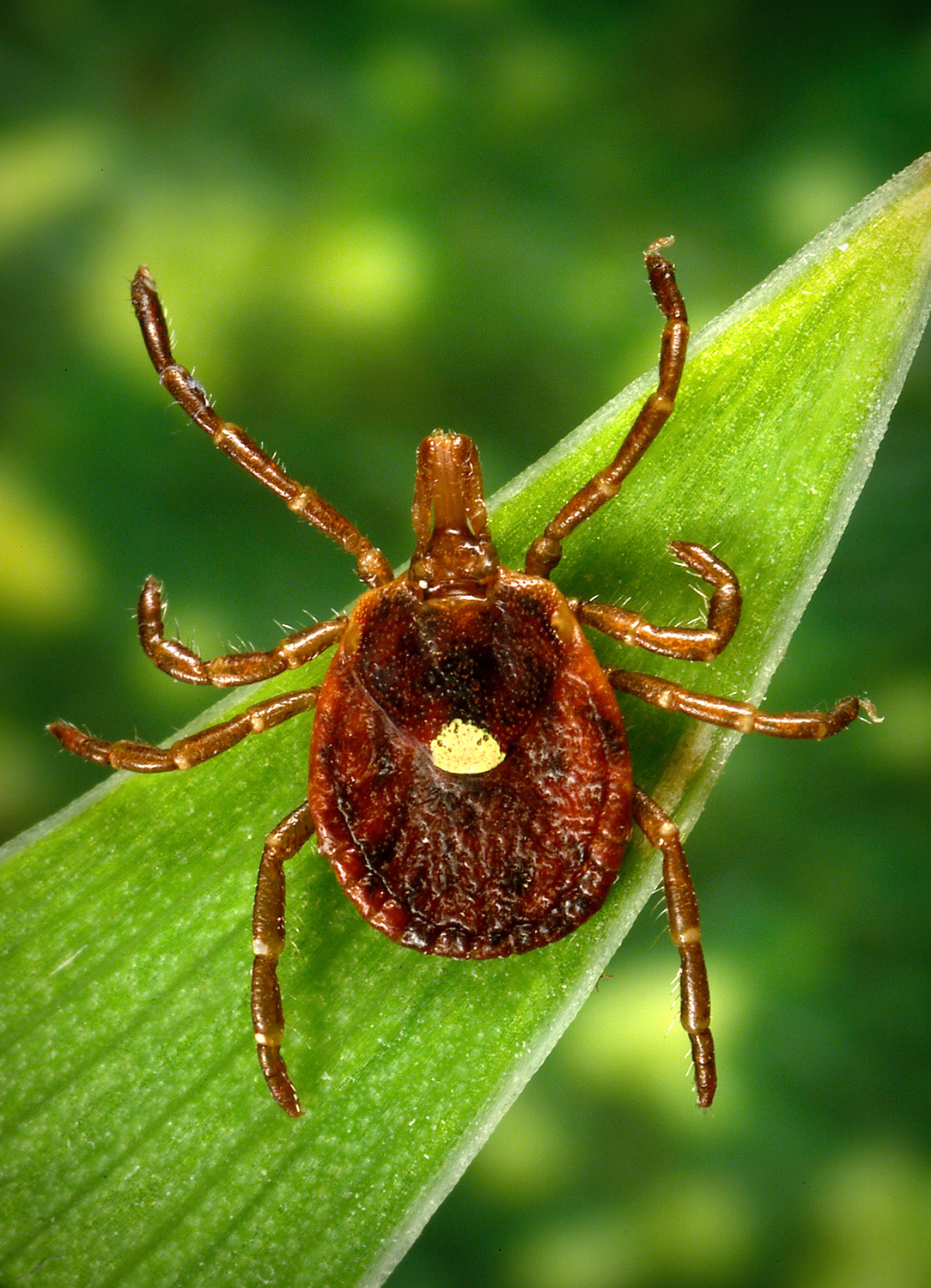
The lone star tick is named for a white mark on the female’s back, not after Texas, the Lone Star State, as many people assume. Photo by Scott Camazine/Alamy Stock Photo
For if there is anything straightforward to learn from my tick-inspired exploration vacation, it’s that there is nothing straightforward when it comes to ticks and Lyme disease and Martha’s Vineyard. Just when you think you know the story, know how to construct a truthful narrative arc, something completely contradictory pops up. And I should have thought of this at the start. Remember Dick Johnson’s tick-trapping safari? If lone star ticks are any indication, it turns out that maybe the Vineyard won’t become the world’s test tube for Lyme disease treatments and research. Maybe islanders won’t have to worry about chronic illness or culling deer populations. They’ll keep the shower signs telling bathers to watch out for ticks and the Jeopardy game, but they will be about tularemia or diseases unknown, thanks to the thing that is causing the largest collective klong the world has ever known: climate change.
Today, the Vineyard is a tick and Lyme disease paradise. But Telford, it turns out, can imagine what will happen if everything warms up considerably. “Twenty years from now, New England is going to be like Virginia or North Carolina, where there are a few hot spots with Lyme disease,” he says. “Our neighbors to the north will have more Lyme disease and we’ll have next to none.” Then he laughs a little sardonic laugh, which punctuates many of his remarks.
And then I think: great, in 20 years, I won’t have to worry about going to Martha’s Vineyard and being attacked by the ticks I can’t see, carrying a disease I absolutely fear. Instead I will have to worry about walking outside my front door and having the same experience in Ontario.
Great.
And that would be a natural end to this article, but, as I said, the Vineyard doesn’t know what a natural ending to a tick and Lyme disease story is, so there is a coda.
One day near the end of our vacation, the six of us are driving on a classic, stone-fence-lined New England country road edged in black and white and scarlet, the colors of the oaks, beeches, red maples, poison sumac, and other trees growing on what were once sheep farms. All of a sudden, a small and delicate doe emerges from the woods, comes to the edge of the road, starts to cross, stops in the middle, and then looks at us with its eternally innocent and alluring doe eyes. And, without prompting, our young friend exclaims from the back seat, not, “Oh, cute,” or, “Aw, Bambi,” but “TICKS!” And my son-in-law then exclaims, “TICKS!” And my daughter spontaneously adds her voice to the chorus.
And I think: whatever happens in the future, my Vineyard tick- and Lyme disease-inspired klong appears to be—even without anything biting anyone—infectious.
Great.

